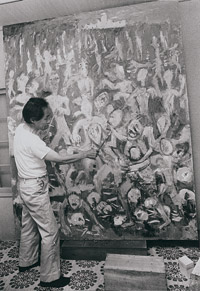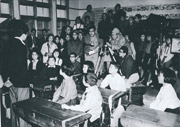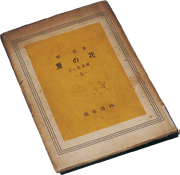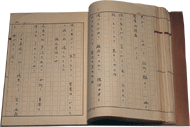 |
|
Memories・Inheritance・Communication
When the movement to ban atomic and hydrogen bombs spread nation-wide in the mid-50s, local media organizations brought hidden issues to light, investigating and gathering information to create their own A-bomb-related reports. The earnest people of Hiroshima supported this endeavor. They consented to interviews and, when requested by the media, sketched-with trembling hands-A-bomb drawings on the backs of advertising fliers and sent them in.
With individual residents helping the media successfully transcend the ordinary news framework, over time, a more comprehensive portrait of "Hiroshima" has been drawn in the daily news. In time, the hibakusha, having long remained mute about their terrible experiences, gradually felt moved to speak. Many now take the initiative to pass their stories on to future generations. They use testimonials, photos, journals and drawings. The methods may differ, but not the motivation: to prevent repetition of the tragedy. That message, now being entrusted by the hibakusha to generations with no experience of war, is spreading. |
|||||||||||||||||||||||||||||||||||||||||||||||||||||||||||||||||||||||||||||||||||||
|
|||||||||||||||||||||||||||||||||||||||||||||||||||||||||||||||||||||||||||||||||||||
| |||||||||||||||||||||||||||||||||||||||||||||||||||||||||||||||||||||||||||||||||||||
Reporting the Atomic Bombing
|
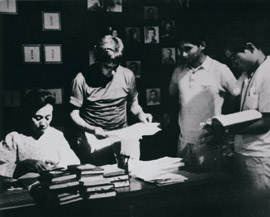 78*A-bomb reporting by local mass media 1969 Courtesy of Hiroshima Telecasting Co., Ltd. Hiroshima mass media have produced several radio and TV programs and published special feature articles regarding the atomic bombing. Many have gone beyond the normal news framework to conduct exhaustive studies and major campaigns to help gather A-bomb materials. In some cases, campaigns initiated by media organizations have been taken up and expanded by the public at large. The photo shows the team that produced the docudrama "Monument" at work. 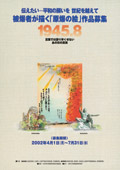 |
 79*Record of 1st Year Students of (Former) Second Hiroshima Junior High school Donated by Hiroshima Telecasting Co., Ltd. The docudrama Monument created by Hiroshima Telecasting Company in 1969 was largely based on these accounts written by bereaved families. To create the program, Hiroshima Telecasting Company investigated the story for roughly half a year. This section contains the stories written by the bereaved families of 209 first-year students of Second Hiroshima Prefectural Junior High School. Monument won a number of awards. |
|||
|
80*NHK Hiroshima Broadcasting Station solicits "A-bomb drawings by survivors"
This poster requesting drawings was jointly produced in 2002 by NHK Hiroshima Broadcasting Station, Hiroshima Peace Memorial Museum, and Chugoku Shimbun. A single drawing by a survivor in 1974 inspired NHK Chugoku Headquarters to put out a general call to survivors asking them to "leave for posterity your drawings of the atomic bombing." In response, 758 people submitted 2,225 drawings. Now among the Museum's most powerful materials, these drawings visually depict the conditions after the A-bombing. Another solicitation campaign took place in 2002, and today, the Museum has 3,563 drawings in its collection. |
||||
Passing on the A-bomb Experience
|
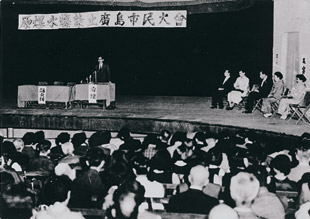 81*The start of A-bomb testimonials
81*The start of A-bomb testimonials
May 15, 1954 Children's Culture Center Courtesy of Chugoku Shimbun As the campaign to ban A- and H-bombs rapidly built momentum nationwide in the late 1950s, the survivors reluctantly began talking about their tragic experiences. With school excursions to Hiroshima increasing in the 1970s, survivors began regularly telling their A-bomb experiences to school children and other groups. This photo shows a survivor at the podium giving his eyewitness testimony the 1954 Hiroshima Citizens' Conference against Atomic and Hydrogen Bombs. |
82*A-bomb Testimonials
Responding to requests for A-bomb accounts told by the survivors themselves, a number of survivor groups formed to present testimonials to schools and other groups. The graph shows the numbers of A-bomb testimonials given by 18 organizations participating in the Gathering for A-bomb Witnesses. The figures have grown each year, doubling in the 17 years between 1987 and 2003. 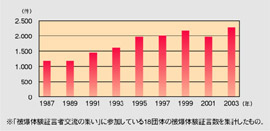 |
|||
|
83*Spreading the spirit of Hiroshima
June 4, 2005 Peace Memorial Park Photo by and courtesy of Kunifusa Seki "You can't possibly understand." "I don't want to remember." For years, these sentiments kept most survivors from speaking about their experiences. But even then, some survivors overcame their personal feelings to speak repeatedly, hoping to help prevent a repetition of their tragedy. A few Hiroshima survivors still speak about their tragic experiences. In the photo, Michiko Yamaoka (75) tells her experience to a group of junior high school students. |
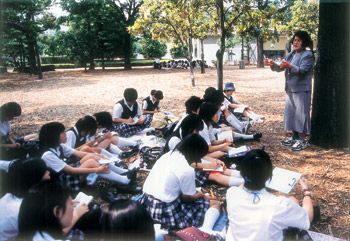 |
|||
| Rising from the Ruins -the Peace Memorial Museum and Hiroshima
1945-1954 Collecting Rubble on the Burnt Plain 1955-1974 Buildings Rising from the Ruins 1975-1990 A Place to Tell the A-bomb Story 1991 - Conveying the Spirit of Hiroshima to the World Eyes of the World Visitors to Hiroshima Museum Statistics Sixty Years for Hiroshima Preservation・Restoration・For Posterity Memories・Inheritance・Communication Conclusion Return to TOP |

